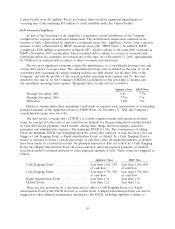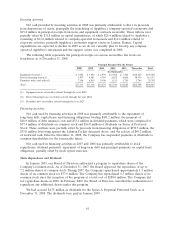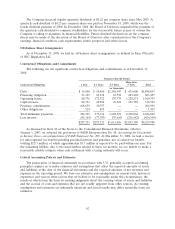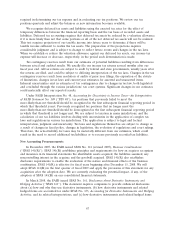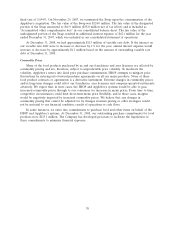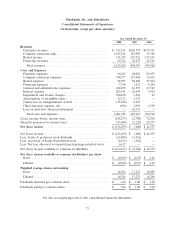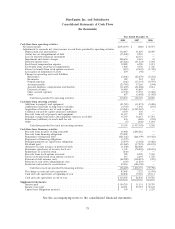IHOP 2008 Annual Report Download - page 81
Download and view the complete annual report
Please find page 81 of the 2008 IHOP annual report below. You can navigate through the pages in the report by either clicking on the pages listed below, or by using the keyword search tool below to find specific information within the annual report.required in determining our tax expense and in evaluating our tax positions. We review our tax
positions quarterly and adjust the balances as new information becomes available.
We recognize deferred tax assets and liabilities using the enacted tax rates for the effect of
temporary differences between the financial reporting basis and the tax basis of recorded assets and
liabilities. Deferred tax accounting requires that deferred tax assets be reduced by a valuation allowance
if it is more likely than not that some portions or all of the net deferred tax assets will not be realized.
This test requires projection of our taxable income into future years to determine if there will be
taxable income sufficient to realize the tax assets. The preparation of the projections requires
considerable judgment and is subject to change to reflect future events and changes in the tax laws.
When we establish or reduce the valuation allowance against our deferred tax assets, our income tax
expense will increase or decrease, respectively, in the period such determination is made.
Tax contingency reserves result from our estimates of potential liabilities resulting from differences
between actual and audited results. We usually file our income tax returns several months after our
fiscal year end. All tax returns are subject to audit by federal and state governments, usually years after
the returns are filed, and could be subject to differing interpretation of the tax laws. Changes in the tax
contingency reserves result from resolution of audits of prior year filings, the expiration of the statute
of limitations, changes in tax laws and current year estimates for asserted and unasserted items.
Inherent uncertainties exist in estimates of tax contingencies due to changes in tax law, both legislated
and concluded through the various jurisdictions’ tax court systems. Significant changes in our estimates
could materially affect our reported results.
Under FASB Interpretation No. 48, Accounting for Uncertainty in Income Taxes—An Interpretation
of FASB Statement No. 109 (‘‘FIN 48’’), tax positions that previously failed to meet the
more-likely-than-not threshold should be recognized in the first subsequent financial reporting period in
which that threshold is met. Previously recognized tax positions that no longer meet the
more-likely-than-not threshold should be derecognized in the first subsequent financial reporting period
in which that threshold is not longer met. We are subject to taxation in many jurisdictions, and the
calculation of our tax liabilities involves dealing with uncertainties in the application of complex tax
laws and regulations in various tax jurisdictions. The application is subject to legal and factual
interpretation, judgment and uncertainty. Tax laws and regulations themselves are subject to change as
a result of changes in fiscal policy, changes in legislation, the evolution of regulations and court rulings.
Therefore, the actual liability for taxes may be materially different from our estimates, which could
result in the need to record additional tax liabilities or to reverse previously recorded tax liabilities.
New Accounting Pronouncements
In December 2007, the FASB issued SFAS No. 141 (revised 2007), Business Combinations
(‘‘SFAS 141(R)’’). SFAS 141(R) establishes principles and requirements for how an acquirer recognizes
and measures in its financial statements the identifiable assets acquired, the liabilities assumed, any
noncontrolling interest in the acquiree and the goodwill acquired. SFAS 141(R) also establishes
disclosure requirements to enable the evaluation of the nature and financial effects of the business
combination. SFAS 141(R) is effective for fiscal years beginning after December 15, 2008. We will
adopt SFAS 141(R) in the first quarter of fiscal 2009 and apply the provisions of this statement for any
acquisition after the adoption date. We are currently evaluating the potential impact, if any, of the
adoption of SFAS 141(R) on our consolidated financial statements.
In March 2008, the FASB issued SFAS No. 161, Disclosures about Derivative Instruments and
Hedging Activities (‘‘SFAS 161’’). This statement requires companies to provide enhanced disclosures
about (a) how and why they use derivative instruments, (b) how derivative instruments and related
hedged items are accounted for under SFAS No. 133, Accounting for Derivative Instruments and Hedging
Activities, and its related interpretations, and (c) how derivative instruments and related hedged items
67




